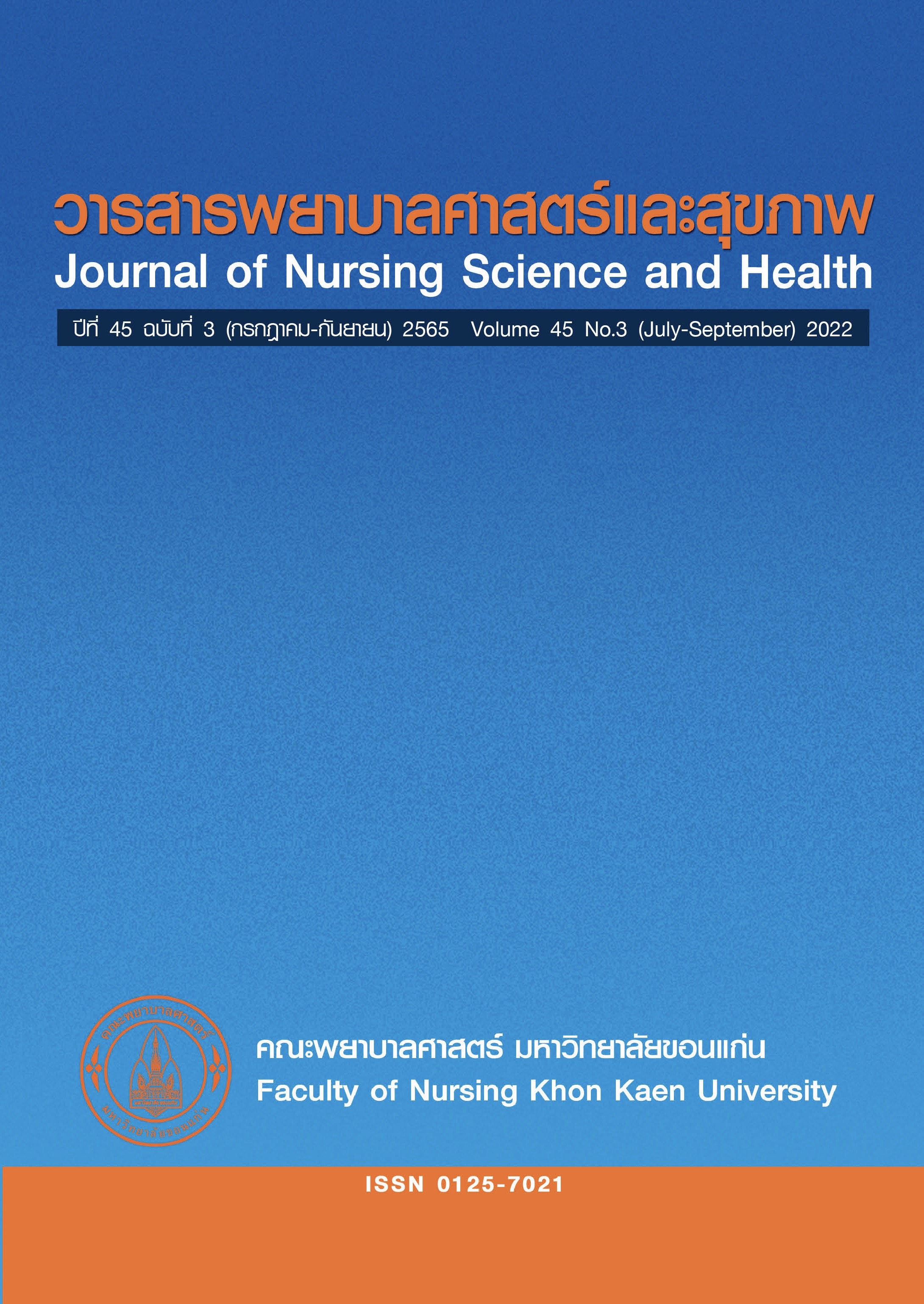การพยาบาลทารกแรกเกิดที่ได้รับการจัดการลดอุณหภูมิร่างกายตามเป้าหมายภายหลังหัวใจหยุดเต้น: กรณีศึกษา
คำสำคัญ:
การจัดการลดอุณหภูมิร่างกายตามเป้าหมาย , การพยาบาล , ทารกแรกเกิด , ภายหลังหัวใจหยุดเต้นบทคัดย่อ
ทารกแรกเกิดที่มีภาวะหัวใจหยุดเต้นส่งผลให้สมองขาดออกซิเจน ทารกจะได้รับการรักษาเพื่อฟื้นฟูการทำงานของสมองโดยการจัดการลดอุณหภูมิร่างกายตามเป้าหมาย (targeted temperature management: TTM) พยาบาลซึ่งเป็นผู้ที่ให้การดูแลผู้ป่วยทารกแรกเกิดวิกฤตอย่างใกล้ชิด จึงต้องมีความรู้และทักษะการปฏิบัติที่ถูกต้องในการดูแลทารกแรกเกิดที่ได้รับการรักษาด้วย TTM เพื่อป้องกันและแก้ไขภาวะแทรกซ้อนที่อาจจะเกิดขึ้น รวมทั้งคงไว้ซึ่งผลลัพธ์ทางประสาทวิทยาคลินิก (neurological outcome) ที่ดี
บทความนี้ได้นำเสนอบทบาทพยาบาลในการดูแลผู้ป่วยทารกแรกเกิดที่ได้รับการรักษาด้วย TTM ภายหลังหัวใจหยุดเต้น เกี่ยวกับความรู้ และหลักการพยาบาลทารกแรกเกิดที่ได้รับการรักษาด้วย TTM เพื่อพัฒนาศักยภาพพยาบาลให้มีความรู้ ทักษะ และการจัดการความรู้ในการดูแลทารกแรกเกิดที่ได้รับการรักษาด้วย TTM เชื่อมโยงกับความรู้ตามบทบาทของพยาบาลในการดูแลจากกรณีศึกษา พร้อมทั้งมีข้อเสนอแนะบทบาทพยาบาลในการติดตามประเมินผลผู้ป่วยก่อนจำหน่ายออกจากโรงพยาบาล การปรับปรุงแนวปฏิบัติการพยาบาลให้มีประสิทธิภาพ
เอกสารอ้างอิง
Ankanawin U. Therapeutic hypothermia after cardiac arrest. JRTAN 2014;15(2):104-9. (in Thai)
Bucher L, Buruschkin R, Kenyon DM, Stenton K, Treseder S. Improving outcomes with therapeutic hypothermia. Nursing 2013;43(1):30-6.
Somrarnyart M. Nursing care for patients with targeted temperature management post cardiac arrest. Nursing Journal 2017;44(4):206-18. (in Thai)
Chomjit A, Panwatvanich S, Thongchuam Y, Mungtaweepongsa S. Targeted temperature management in traumatic brain injury. Thai Journal of Neurology 2017;33(4):1-14. (in Thai)
Madden LK, Hill M, May TL, Human T, Guanci MM, Jacobi J, et al. The implementation of targeted temperature management: an evidence-based guideline from the neurocritical care society. Neurocrit Care 2017;27(3):468–87.
Longlalerng W. The development of nursing practice guideline for therapeutic hypothemia. Quality improvement program performance report. Pathum Thani: Department of Nursing, Thammasat University;2015. (in Thai)
Harnyoot O. Nursing process and implication. JRTAN 2014;15(3):137-43. (in Thai)
Alfaro-LeFevre R. Applying nursing process: The foundation for clinical reasoning. 8th ed. Philadelphia: Wolters Kluwer;2014.
McDonnell A. Use of targeted temperature management post cardiac arrest. British Journal of Cardiac Nursing 2018;13(11):532–8.
Konmun S, Sriratanaporn S, Kitti-udom S, Muengtaweepongsa S. Targeted temperature management in critical care neurology. J Thai Stroke Soc 2017;16(3):27-48. (in Thai)
Wonganan U. Reducing body temperature in patients with traumatic brain injury, presenting with fever. APHEIT Journal 2015;4(2):75-82. (in Thai)
Taccone FS, Picetti E, Vincent J-L. High quality targeted temperature management (TTM) after cardiac arrest. Crit Care 2020;24(1):1-7.
Saigal S, Sharma JP, Dhurwe R, Kumar S, Gurjar M. Targeted temperature management: Current evidence and practice in critical care. Indian Journal of Critical Care Medicine 2015;19(9):537-46.
Lee YJ. Targeted temperature management and neuroprotective outcomes of pediatric patients after cardiac arrest. Clin Exp Pediatr 2020;63(5):180–1.
Chiu W, Lin K, Tsai M, Hsu C, Wang C, Kuo L, et al. Post-cardiac arrest care and targeted temperature management: A consensus of scientific statement from the Taiwan society of emergency & critical care medicine, Taiwan society of critical care medicine and Taiwan society of emergency medicine. JFMA 2021;120:569-87.
Tantapong E, Thaor S. Effects of implementing the newborn modified early scoring (NEWS) in neonatal care, The Queen Sirikit National Institute of Child Health. JNHR 2021;37(3):76–88. (in Thai)
ดาวน์โหลด
เผยแพร่แล้ว
รูปแบบการอ้างอิง
ฉบับ
ประเภทบทความ
สัญญาอนุญาต
ลิขสิทธิ์ (c) 2022 วารสารพยาบาลศาสตร์และสุขภาพ

อนุญาตภายใต้เงื่อนไข Creative Commons Attribution-NonCommercial-NoDerivatives 4.0 International License.
วารสารพยาบาลศาสตร์และสุขภาพเป็นเจ้าของลิขสิทธิ์ในการเผยแพร่ผลงานที่ตีพิมพ์ห้ามผู้ใดนำบทความที่ได้รับการตีพิมพ์ในวารสารพยาบาลศาสตร์และสุขภาพไปเผยแพร่ในลักษณะต่าง ๆ ดังนี้ การนำบทความไปเผยแพร่ออนไลน์ การถ่ายเอกสารบทความเพื่อกิจกรรมที่ไม่ใช่การเรียนการสอน การส่งบทความไปตีพิมพ์เผยแพร่ที่อื่น ยกเว้นเสียแต่ได้รับอนุญาตจากวารสารพยาบาลศาสตร์และสุขภาพ



